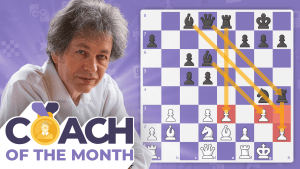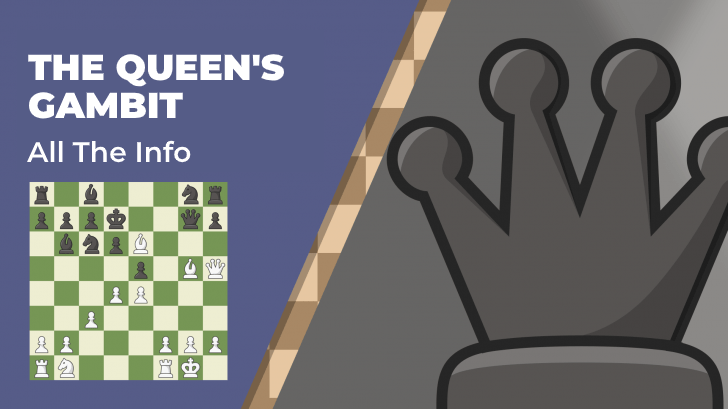
The Queen's Gambit On Netflix - All The Info
The Queen's Gambit has become more than "a chess show." The seven-episode Netflix miniseries has captured the attention of audiences worldwide and was the #1 show in over 12 countries. It has introduced or re-ignited viewers' interest in the royal game—whether you need to learn how the pieces move or if you are already a grandmaster, The Queen's Gambit has something for everyone.
After watching the show many fans simply want more! Well, Chess.com has you covered with lessons, player profiles, chess terms, and openings. Here is a collection of content that is directly related to this brilliant show:
- Brief Synopsis
- Chess Positions
- Chess Mistakes
- Chess Terms
- Chess Players
- Chess Openings
- Episode Summaries
- Awards And Accolades
Brief Synopsis
For those of you who haven't seen the show yet, The Queen's Gambit was adapted from a 1983 novel written by Walter Tevis. It is a story set in the Cold War-era and is a coming-of-age story that explores the true cost of genius: that of Beth Harmon, a highly-talented female chess player. Here is the Netflix description of the show:
Abandoned and entrusted to a Kentucky orphanage, Beth (played by Isla Johnston in her early years but mostly by Anya Taylor-Joy) discovers an astonishing talent for chess while developing an addiction to tranquilizers provided by the state as a sedative for the children.
Haunted by her personal demons and fueled by a cocktail of narcotics and obsession, she transforms into an impressively skilled and glamorous outcast while determined to conquer the traditional boundaries established in the male-dominated world of competitive chess.
The series is written and directed by Academy Award nominee Scott Frank (Minority Report, Logan, Godless) and executive produced by Frank, William Horberg (The Talented Mr. Ripley), and Allan Scott (Don’t Look Now, The Preacher’s Wife), who also co-created the series.
You can read Chess.com's interview with Scott Frank (the writer/director/executive producer of The Queen's Gambit) here or watch Chess.com's interview with Thomas Brodie-Sangster (Benny Watts) here. If you would like to read about the "real-life" Beth Harmon (or at least the chess world's closest equivalent) then this article by FM AndreyTerekhov about Vera Menchik is a great place to start.
If you have already seen the show, here is a fantastic video review by WGM Jennifer Shahade, Chess.com's esports producer Aran Graham, and Chess.com's Chief Chess Officer IM Danny Rensch.
Chess Positions
As we learned in Chess.com's News Director Peter Doggers' interview with Scott Frank, chess is done right in The Queen's Gambit. They had the legendary world champion GM Garry Kasparov and the famous chess instructor NM Bruce Pandolfini on set to help with all of the chess scenes. They showed the actors how to move pieces properly, how to hit the clock, and also helped with many of the chess references used in the show. Many of these games are real games played by real players.
Here is an excellent lesson series by Chess.com's Jeremy Kane containing many positions from the show. If you'd like to dig even deeper, here is a video lesson by GM Simon Williams on Beth Harmon's top five moves.
If you'd like to take a closer look at the chess positions featured on the show, you can also check out this article where we go over almost every chess position from The Queen's Gambit.
Chess Mistakes
Even though the chess in The Queen's Gambit was done extremely well, the keenest eyes have found a few mistakes. Chess.com's October 2020 Blog of the Month (written by Chess.com user Rocky64) found an almost imperceptible mistake during a specific scene. Chess.com's Director of Content NM Sam Copeland has a great blog on some of these slight errors here.
Chess Terms
The Queen's Gambit mentions many, many chess terms. Here is a glossary of most of these chess terms:
- Backward Pawn is mentioned in the first episode. It is a type of pawn seen in many different pawn structures.
- Blunder refers to a bad move—usually an error that costs someone the game.
- Checkmate is displayed in the first episode and shown multiple times throughout the series. Delivering checkmate is how a player wins a game of chess.
- Chessboards are seen in every episode. This is what we place the pieces on.
- Chess Clocks are seen throughout the show. These are used to time chess games.
- Chess Matches are featured heavily in the show. These refer to a game or series of chess games.
- Chess Pieces are on the screen in every episode—sometimes on the ceiling!
- Chess Problems are featured heavily when Beth meets a chess problemist. They are chess positions or puzzles that are created or shown to be solved.
- Chess Ratings are first discussed in the second episode. These are a way of measuring a player's relative strength.
- Chess Strategy is mentioned throughout the show. Strategy refers to long-term planning and other ideas in chess.
- Draw is a way that any game can end where neither player wins or loses.
- Endgames are referred to often. This is the final phase of a chess game, where there are fewer pieces remaining on the board.
- Exchanges is the title of the second episode. In chess, exchanges occur when chess pieces are traded for one another.
- Fast Chess (also known as blitz chess) is shown in the show. This is a game of chess with a fast time control (usually five minutes or less per player).
- Fork is mentioned throughout the show. It is a common chess tactic, usually conducted by a knight.
- Grandmaster is the highest chess title that can be attained.
- Notations are seen in many scenes. This is how chess players write down or discuss moves in a chess game.
- Scholar's Mate is also seen in the first episode. It is usually the first checkmate/opening trap that chess players learn.
Chess Players
Although Beth Harmon and the characters in The Queen's Gambit are fictional, there are many references to famous chess players. Here are some of the players mentioned in the show:
Jose Raul Capablanca
Jose Raul Capablanca is mentioned in the second episode where Beth asks the school librarian if there are any books about chess—Beth even thumbs through one of his books. Capablanca was the third world champion (from 1921 through 1927) and is well-known for his legendary endgame skills and all-around positional proficiency. He didn't lose a single tournament game during an eight-year span from 1916-1924. He is widely accepted as one of the best players of all time.

Paul Morphy
Paul Morphy was the embodiment of romantic attacking chess and the strongest player of the entire 19th century. The American chess genius had a relatively short career, but he convincingly defeated the world's best players at the time and his Opera Game is considered to be one of the most famous games ever played.
Vasily Smyslov
GM Vasily Smyslov was the seventh world champion and still holds the record for most Chess Olympiad medals, with 17 total medals. He is remembered for his machine-like technical skill in the endgame.
Mikhail Botvinnik
GM Mikhail Botvinnik was the sixth world champion and held the title from 1948 through 1963 (with two one-one year exceptions in 1957 and 1960). Widely accepted as one of the strongest players of all time, he also coached three world champions (GMs Kasparov, Anatoly Karpov, and Vladimir Kramnik).
Alexander Alekhine
Alexander Alekhine is mentioned by different characters throughout the series. In episode five, Benny Watts says that Beth "attacks like Alekhine"—a player known for his vicious combinations in complex positions. Alekhine was the fourth world champion and he taught the chess world that rules and principles can be broken based on concrete analysis of the specific position.

Boris Spassky
GM Boris Spassky was the 10th world champion (from 1969-1972) and is a chess legend. He was a world championship candidate from 1956-1980 and became a worldwide celebrity during his 1972 World Championship match with the American GM Bobby Fischer.
Samuel Reshevsky
GM Samuel "Sammy" Reshevsky was one of the greatest American players in history. He won the US Championships seven times and competed in the 1948 World Championship. His career is also remembered for its longevity—he defeated every world champion from Emanuel Lasker through Fischer.
Efim Bogoljubov
GM Efim Bogoljubov was a world-class player who fought for the world championship twice against Alekhine. He was the first FIDE world champion in 1928 and a two-time Soviet champion.
Nona Gaprindashvili
Nona Gaprindashvili became the Women's World Champion at the age of 20 and held the title for 16 years (from 1962-1978). She was the first woman to be awarded the grandmaster title in history. She is widely accepted as one of the strongest female chess players of all time.
There are many other famous chess players highlighted in The Queen's Gambit including Francois Philidor, Wilhelm Steinitz, Jacques Mieses, GM Reuben Fine, Ernst Grunfeld, GM Wolfgang Uhlmann, Hans Kmoch, Vasily Panov, GM Miguel Najdorf, Vladas Mikenas, GM Jonathan Penrose, and more.
Chess Openings
It is not only chess terms and players that are highlighted in the series—chess openings also share the spotlight. Here is a list of some of the openings played or discussed by the characters, with links to Chess.com material.
The Queen's Gambit
The Queen's Gambit is the opening that is most referenced in the show, and the opening that the miniseries gets its name from. The opening is an excellent metaphor for Beth's life—sacrifices and hardships lead her to the top. The show displays both the Queen's Gambit Accepted and the Queen's Gambit Declined.
After 1.d4 d5 2.c4 the starting position for the Queen's Gambit is reached:
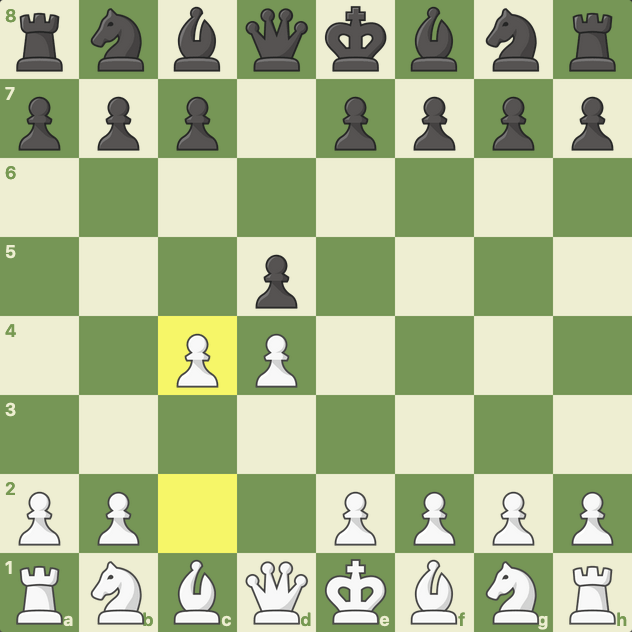
Black accepts the gambit by capturing the c4-pawn with 2... dxc4, and can decline it by playing 2... e6. Here is a short introductory video lesson on the Queen's Gambit for newer players, and here is great video lesson series on the Queen's Gambit Declined for more advanced players by GM Gregory Kaidanov.
The Sicilian Defense
The Sicilian Defense is another heavily featured opening. Mr. Shaibel, the janitor, was the first to introduce this opening to Beth in the first episode. It is an aggressive opening that Beth adds to her opening repertoire immediately, and is still the most popular choice to meet 1.e4 today.
The Sicilian Defense is reached after the moves 1.e4 c5:
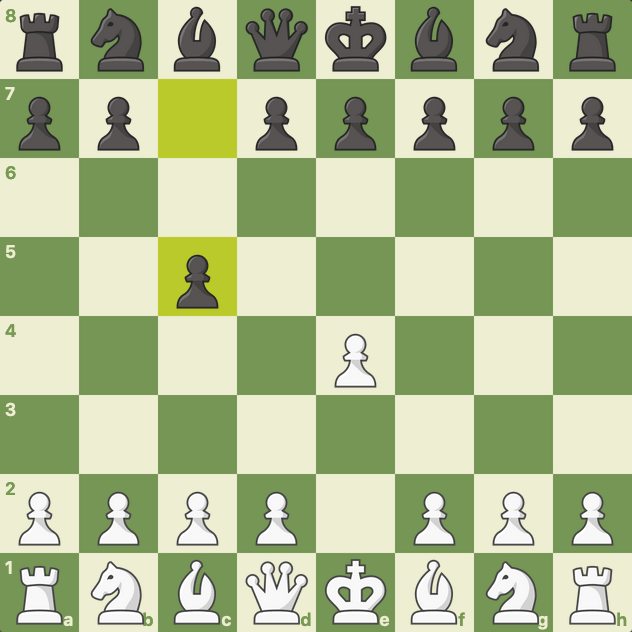
Although there are many variations of the Sicilian Defense in the show (Sicilian dragon, Levenfish attack, Rossolimo attack, Scheveningen, and more) the Najdorf variation is mentioned and displayed the most. Benny Watts plays the Najdorf against Beth in their first meeting and Beth plays it herself. It is a very difficult opening line to master because of its many subvariations and advanced themes—a challenge that does not intimidate the eight-year-old Beth.
The Najdorf variation of the Sicilian Defense is reached after the moves 1.e4 c5 2. Nf3 d6 3. d4 cxd4 4. Nxd4 Nf6 5. Nc3 a6:

Here is a short introductory video lesson on the Sicilian Defense.
The Caro-Kann Defense
The Caro-Kann Defense is another mainstream opening that appears in the miniseries. Beth's friend and opponent in the final round of the 1963 Kentucky State Championship, Harry Beltik, plays this defense against her, and Benny Watts is talking about this opening with a small crowd when Beth first meets him. Unlike the Sicilian Defense, the Caro-Kann is not aggressive and has a very solid reputation. It is reached after the moves 1. e4 c6 2. d4 d5:

Here is a short introductory video lesson on the Caro-Kann Defense and here is a more comprehensive video lesson series for advanced players on the Caro-Kann by GM Sam Shankland. Below you will find another introductory video by IM David Pruess:
The Reti Opening
This hypermodern opening for White was played by Beth against Mr. Ganz, Duncan High School's chess coach. Unlike the popular openings 1. e4 and 1. d4, the Reti Opening does not begin the game with a pawn move. Instead, it develops a knight to control the center and begins with 1. Nf3:

You can learn more about the Reti opening here at Chess.com/openings.
The King's Gambit
Shirley Munson, one of Mr. Ganz's students and treasurer of the chess club, asks Beth if she plays the King's Gambit. This dialogue occurs when both girls are on their way to Beth's simul in Duncan High School's chess club. The King's Gambit is a romantic attacking opening and was one of the most popular openings of the 19th century, though it has fallen out of favor in more recent times. It begins with moves 1. e4 e5 2.f4:
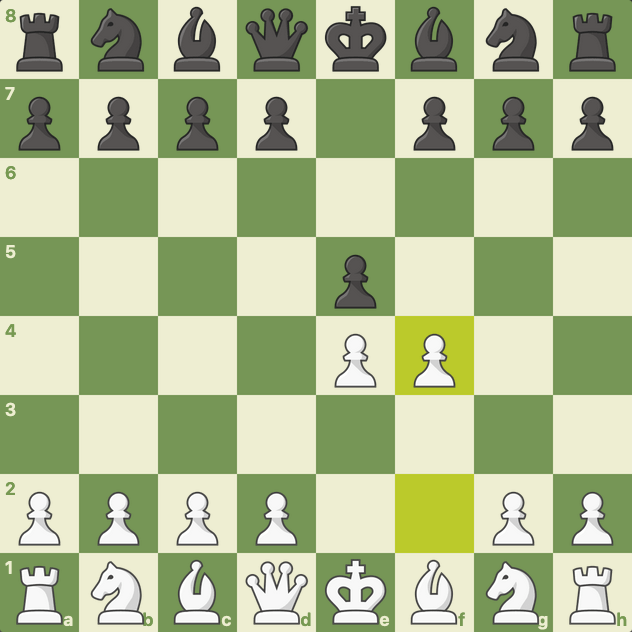
Here is an introductory video on the King's Gambit, and here is a more advanced video lesson series on the King's Gambit by GM Simon Williams.
The Marshall Attack (Ruy Lopez)
Beth mentions that she played "the Marshall" when talking to her mother while playing in the US Open. She is referring to the Marshall Attack, an aggressive and advanced variation for Black in the very popular Ruy Lopez opening. After the moves 1. e4 e5 2. Nf3 Nc6 3. Bb5 the Ruy Lopez' starting position is reached:
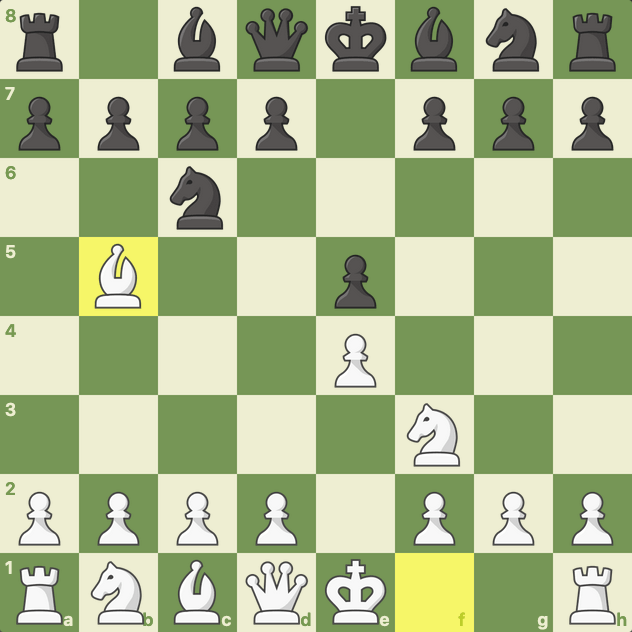
The Marshall Attack occurs after the moves 1. e4 e5 2. Nf3 Nc6 3. Bb5 a6 4. Ba4 Nf6 5. 0-0 Be7 6. Re1 b5 7. Bb3 0-0 8. c3 d5:
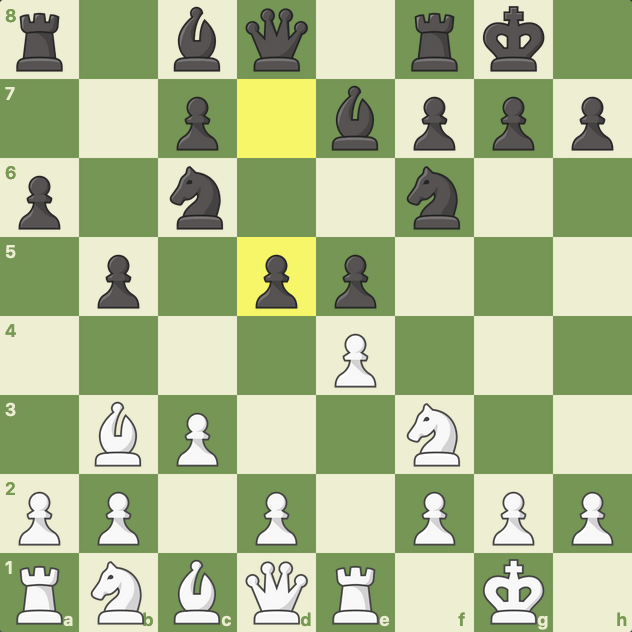
This advanced line is covered in great detail in a video lesson series by Chess.com's NM Jeremy Kane.
Episode Summaries
Do you need a refresher on what happened in the show? What about a breakdown of each episode by none other than IM Danny Rensch himself? We've got you covered!
Episode 1 - Openings
Elizabeth "Beth" Harmon goes to an orphanage after her mother dies when she is only eight-years-old. She soon develops an obsession with chess after seeing the janitor, Mr. Shaibel, playing it in the basement. She also becomes addicted to tranquilizers that the staff gives to all of the orphans.
IM Danny Rensch and chess enthusiast James Montemagno's did a breakdown of the first episode of The Queen's Gambit on their podcast, blunders.fm. Check it out below:
Episode 2 - Exchanges
Teenage Beth gets adopted and moves to a house in the suburbs. As she struggles to adapt to her new life, she devises a plan to enter a chess tournament.
Listen to the breakdown of this episode below:
Episode 3 - Doubled Pawns
Beth goes to Cincinnati to play in a tournament and her performance puts her in the limelight. Many tournaments and media appearances later, Beth sets her eyes on the US Open.
Here's the episode breakdown:
Episode 4 - Middle Game
Beth takes Russian classes and widens her social circle. She goes to Mexico City to play in an invitational tournament where she faces Grandmaster Borgov for the first time. Beth's mother comes along to meet an old friend.
Episode breakdown? Here we go!
Episode 5 - Fork
Beth is back in Kentucky and reconnects with an old opponent who offers to help her prepare for the US Championship.
Episode 6 - Adjournment
After training with Benny Watts in New York, Beth goes to a tournament in Paris where she will face Borgov again. However, a crazy night sends Beth on a self-destructive streak.
Episode 7 - End Game
Beth gets reunited with an old friend and comes to terms with her past and priorities. She goes to Russia to play the biggest match of her life.
Awards And Accolades
The Queen's Gambit was not only well received by the public in general, but also received numerous accolades and awards. Below you can see a list of the most prestigious accolades the show received:
Golden Globes Awards, 2021
- Best Television Limited Series, Anthology Series or Motion Picture Made for Television
- Best Performance by an Actress in a Limited Series, Anthology Series or a Motion Picture Made for Television (Anya Taylor-Joy)
Emmy Nominations
- Outstanding Limited or Anthology Series
- Outstanding Lead Actress in a Limited or Anthology Series or Movie (Anya Taylor-Joy)
- Outstanding Supporting Actress in a Limited or Anthology Series or Movie (Moses Ingram)
- Outstanding Supporting Actor in a Limited or Anthology Series or Movie (Thomas Brodie-Sangster)
- Outstanding Directing for a Limited or Anthology Series or Movie
- Outstanding Writing for a Limited or Anthology Series or Movie
- Outstanding Casting for a Limited or Anthology Series or Movie
- Outstanding Production Design for a Narrative Period or Fantasy Program (One Hour Or More)
- Outstanding Cinematography For A Limited Or Anthology Series Or Movie
- Outstanding Period Costumes
- Outstanding Single-Camera Picture Editing For A Limited Or Anthology Series Or Movie
- Outstanding Main Title Design
- Outstanding Period And/Or Character Makeup (Non-Prosthetic)
- Outstanding Music Composition For A Limited Or Anthology Series, Movie Or Special (Original Dramatic Score)
- Outstanding Original Music And Lyrics
- Outstanding Music Supervision
- Outstanding Sound Editing For A Limited Or Anthology Series, Movie Or Special
- Outstanding Sound Mixing For A Limited Or Anthology Series Or Movie
We hope you enjoyed this article and the miniseries. Keep an eye on this article, as we will be expanding on it as more content is created! Let us know your favorite part of the show in the comments below.
